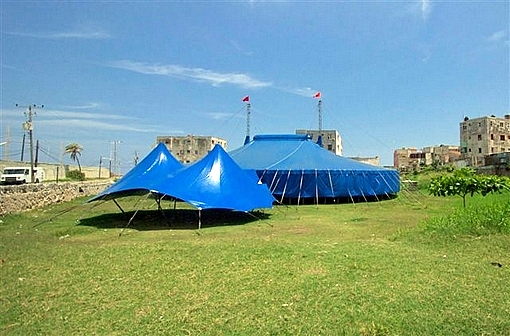Wifredo Lam Contemporary Art Center ,
May 11, 2012 - Jun 11, 2012
La Habana Vieja, Cuba
11th Havana Biennial
by Magaly Espinosa
The 11th Havana Biennial and the "Other" Biennial May you live in interesting times.*
Llilian Llanes. The 11th Havana Biennial is a difficult one to catch. It has so many arms that you would get lost watching its fascinating movements, dancing and walking at the same time. The event itself was launched in 1984, under the direction of the Visual Arts Department of the Ministry of Culture (MINCUL), a year after its sponsor, the Wifredo Lam Center, was created. As it emerged into a new option for the art made in the "Third World", it started taking shape as a gathering space for discovering and becoming acquainted with many of the best art producers working in that context. Referring to the second edition, the critic and curator Gerardo Mosquera described it as "…the first global exhibition of contemporary art, featuring 2 400 works by contemporary artists hailing from 57 countries, three years before Les Magiciens de la Terre… thus launching the new era of internationalization that we are currently experiencing…"(1). The biennial was as a model for providing responses to relations between the global and the local, the centers and the peripheries, and their mutual exchanges. From the viewpoint of Latin American critical thought, biennials provide major opportunities to reflect on howthe mechanisms under which cultural exchanges, representation politics and the dissimilar levels at which such relations are promoted actually work. Tracing those aims through the different editions would imply mapping the history of one of the important series of events in the world of art from the periphery. Although it is beyond the purview of this article, such an endeavor should be taken into account while trying to understand to what extent the Biennial’s original "third world" calling has been maintained or diluted. Naturally this ties in with the aims set for its eleventh edition: continuing to see itself as a leading axis point for reflections on the political role subaltern geographies can play by joining, or taking part in, the global processes that characterize today’s world.(2) For an overview of this event, one must take into consideration how the different levels of national and international exhibitions were linked. We should also consider this edition’s theme, how cohesively it ran through the exhibition with the aid of the theoretical sections of the Biennial. Considering the enormous effort thatholding an event of this magnitude involves given Cuba’s current socio-economic conditions, we should be thankful that it continues to be held, but we must also take into account the responsibility that it carries and that must not be ignored. In that sense its achievements include the following: the wide-ranging participation of young artists within the roster of official guests, since this always carries its own risks, given the substantially quantitative increases in the number of Cuban visual artists graduating from art schools;the presence of a director of the Biennial and a team of specialists who are familiar with these artists’ production and the implementation of public programs that pointed the city scene towards the Biennial, the most striking being Los Carpinteros’ Conga Reversible, Wilfredo Prieto’s Circo Triste, and Rafael Villares’ Paisaje Itinerante. The presence of international figures also deserves special mention, among them Marina Abramovic, Ilya-Emilia Kavakov, Gabriel Orozco, Andrés Serrano, Pablo Helguera and Iván Navarro, which provided a solid art setting to the event, and lastly the effort made to include other venues, aside from historic buildings, in order to bring the Biennial to other areas of the city. This effort, with all it implied in terms of organization, posed a challenge to the event’s consistency by dispersing it in so many directions that it too often forgot its aims and properly understanding its scope was made difficult. The general statistics on the number of exhibitions, participating artists and curatorial projects that made up the main body of action provides an idea of that dispersal. According to the catalogue, 178 artists from 43 countries took part in the Biennial. The artists showed their work in nearly 80 exhibitions listed on the official program, with an additional 14 more making up the collateral program. Additional exhibits were also organized in houses or workshops, among them the havanaopenhouse project, sponsored by Cuban institutions, which brought together 45 artists in 12 household spaces. Adding further to that highly varied amalgamation were also 6 alternative spaces.To that balance we should add the individual and collective exhibits on display in the vaults of the historical monument known as the Fortaleza de la Cabaña, together with the large number of art students who showed their work at the San Alejandro Academy and the Institute of Higher Art Studies. All that information provides an idea of the sheer size of the Biennial(3) and illustrates our belief that its format, among other factors, could have affected the quality of the exhibitions and the curatorial endeavor as a whole, considering the selectivity that should govern a mega project of this kind. What can be the strategy behind a gathering of this size if its aim is to foster dialogues from the periphery towards the creative discourses within contemporary art, opening up the interpretations and readings behind an art scene whose central merit lies in the fact that its foundation is its social and cultural roots? Is its aim of acting as an alternative space against transnational strategies based on the international market and exchanges with the art world’s power centers still being upheld? What is its role in relation to the art of the country that promotes it? What Biennial model are we really talking about? Allowing subaltern geographies to play an active political role upon joining global processes is possible, as long as that role is consolidated at the local level and indeed within the frameworks of the glocal.
|









